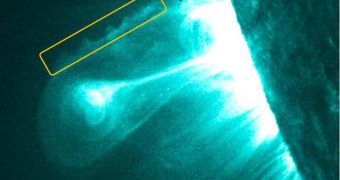Solar physicists keeping tracks of phenomena taking place on the surface of the Sun say that they recently made a discovery that could make predicting space weather more reliable than ever before.
The team conducting the observations says that recent studies managed to capture images of clouds of material being ejected in violent explosions from the surface of the star. These clouds had eerie similarities with clouds in Earth's atmosphere.
If scientists manage to draw parallels between the two types of structures, then predicting the behavior of solar clouds based on the behavior of their counterparts on Earth could become a real possibility.
What physicists need is the certainty that at least the phenomena underlying the formation and behavior of clouds on both celestial bodies are the same. If they are identical, then it doesn't matter if the actual manifestations are different.
The observations that led to the new conclusions were carried out using the NASA Solar Dynamics Observatory (SDO), by a team of experts at the University of Warwick, in the United Kingdom.
The researchers were led by Center for Fusion Space and Astrophysics expert Dr Claire Foullon. The team discovered the cloud-like structures while analyzing images of clouds of material ejected from the stellar surface.
Solar events such as the SDO witnessed and the UK team analyzed are called coronal mass ejections (CME). When they take place, the Sun releases billions of tons of material from its insides into its surroundings. These events can be very dangerous.
If the CME are oriented towards our planet, then the vast amounts of radiation the events produce can easily pass through the magnetosphere, our planet's defensive radiation shield. When this happens, power grids and satellite can be negatively affected, or fried entirely.
With the new observations, the team hopes to be able to analyze CME data as soon as they become available, and determine the type of defensive measures that need to be taken to safeguard Earth.
“The fact that we now know that these [Kelvin-Helmholtz] KH instabilities in CME are so far only observable in the extreme ultra violet , at a temperature of 11 million Kelvin, will also help us in modeling CME behavior,” Dr Claire Foullon explains.
“This new observation may give us a novel insight into why these CME appear to both rotate, and be deflected away from following a simple straight path from the surface of the Sun,” she adds.
“If the instabilities form on just one flank they will may increase drag one side of the CME causing it to move slower than the rest of the CME,” the expert concludes, quoted by Daily Galaxy.

 14 DAY TRIAL //
14 DAY TRIAL //